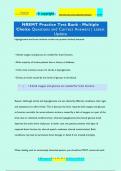2024 /2025 | © copyright | This work may not be copied for profit gain | Excel!
NREMT Practice Test Bank - Multiple
Choice Questions and Correct Answers | Latest
Update
Hypoglycemia and acute ischemic stroke can present similarly because:
• A:both oxygen and glucose are needed for brain function.
• B:the majority of stroke patients have a history of diabetes.
• C:the most common cause of a stroke is hypoglycemia.
• D:they are both caused by low levels of glucose in the blood.
✓ -:- • A:both oxygen and glucose are needed for brain function.
Reason: Although stroke and hypoglycemia are two distinctly different conditions, their signs
and symptoms are often similar. This is because the brain requires both oxygen and glucose
to function normally. An acute ischemic stroke is caused by a lack of oxygen to a part of the
brain due to a blocked cerebral artery, whereas hypoglycemia (low blood glucose level)
deprives the entire brain of glucose. In either case, the patient presents with signs of
impaired brain function (ie, slurred speech, weakness, altered mental status). Both
conditions may lead to permanent brain damage or death if not treated promptly.
When dealing with an emotionally disturbed patient, you should be MOST concerned with:
1|P a g e | G r a d e A + | 2 0 2 0 2 5
,2024 /2025 | © copyright | This work may not be copied for profit gain | Excel!
• A:gathering all of the patient's medications.
• B:safely transporting to the hospital.
• C:whether the patient could harm you.
• D:obtaining a complete medical history.
✓ -:- You selected C; This is correct!
Reason: When managing any patient with an emotional or psychiatric crisis, your primary
concern is your own safety. Safely transporting the patient to the hospital is your ultimate
goal. If possible, you should attempt to obtain a medical history and should take any of the
patient's prescribed medications to the hospital. However, this should not supercede your
own safety or interfere with safely transporting the patient.
You are at the scene where a man panicked while swimming in a small lake. Your initial
attempt to rescue him should include:
• A:rowing a small raft to the victim.
• B:reaching for the victim with a long stick.
• C:throwing a rope to the victim.
• D:swimming to the victim to rescue him.
✓ -:- You selected B; This is correct!
2|P a g e | G r a d e A + | 2 0 2 0 2 5
,2024 /2025 | © copyright | This work may not be copied for profit gain | Excel!
Reason: General rules to follow when attempting to rescue a patient from the water include
"reach, throw, row, and then go." In this case, you should attempt to reach the victim by
having him grab hold of a large stick or similar object. If this is unsuccessful, throw the victim
a rope or flotation device (if available). If these are not available, row to the patient in a
small raft (if available). Going into the water to retrieve the victim is a last resort. The
rescuer must be a strong swimmer because patients who are in danger of drowning are in a
state of blind panic and will make every attempt to keep themselves afloat, even if it means
forcing the rescuer underwater.
How should you classify a patient's nature of illness if he or she has a low blood glucose
level, bizarre behavior, and shallow breathing?
• A:Behavioral emergency
• B:Altered mental status
• C:Respiratory emergency
• D:Cardiac compromise
✓ -:- The correct answer is B;
Reason: The nature of illness (NOI) is the medical equivalent to mechanism of injury (MOI).
Altered mental status should be the suspected NOI in any patient with any fluctuation in
3|P a g e | G r a d e A + | 2 0 2 0 2 5
, 2024 /2025 | © copyright | This work may not be copied for profit gain | Excel!
level of consciousness, which can range from bizarre behavior to complete
unresponsiveness. Causes of an altered mental status include hypo- or hyperglycemia, head
trauma, stroke, behavioral crises, drug overdose, and shock, among others.
A young female is unresponsive after overdosing on an unknown type of drug. Her
respirations are slow and shallow and her pulse is slow and weak. Which of the following
drugs is the LEAST likely cause of her condition?
• A:Seconal
• B:Heroin
• C:Cocaine
• D:Valium
✓ -:- The correct answer is C;
Reason: Of the drugs listed, cocaine would be the least likely cause of the patient's
condition. Cocaine is a central nervous system (CNS) stimulant; you would expect her to be
hypertensive, tachycardic, tachypneic, and perhaps even violent. Heroin, Valium, and Seconal
are all CNS depressants and could explain her condition. Heroin is an illegal narcotic
(opiate), Valium is a benzodiazepine sedative-hypnotic drug, and Seconal is a barbiturate.
Narcotics, benzodiazepines, and barbiturates are all CNS depressants. When taken in
excess, they cause a decreased level of consciousness, respiratory depression, bradycardia,
and hypotension.
4|P a g e | G r a d e A + | 2 0 2 0 2 5




